Ducati Multistrada V2
 Photos: Motorradtest.de
Photos: Motorradtest.deDo we still need the Multistrada V4 at all?
The new V2 is not only light, it is now also damn well equipped. Except for a few features, it has everything that the Multistrada V4 has. It costs 15,990 euros, making it almost 5,000 euros cheaper than a V4. Okay, the V4 engine has 55 more horses in the stable, but it also weighs easily 30 kilos more! In terms of length and wheelbase, the two multis don't give each other much.
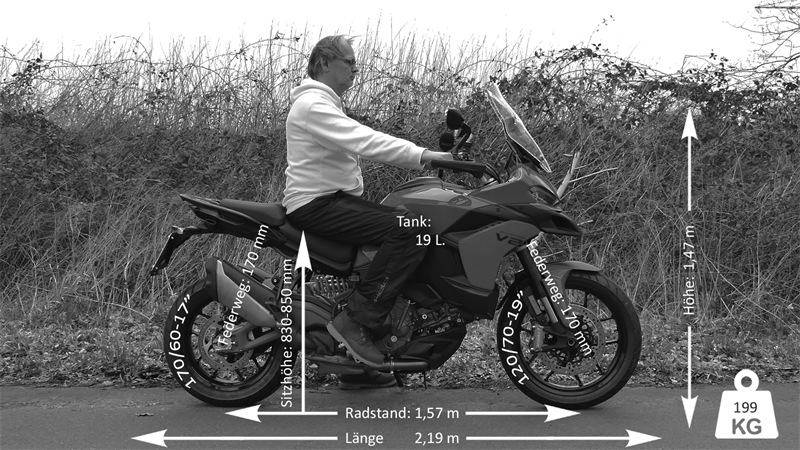
360-degree tour of the new Multistrada V2
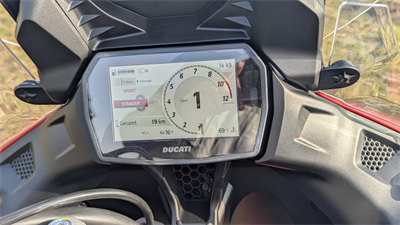
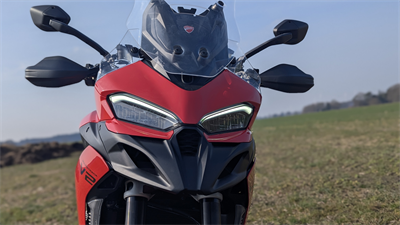
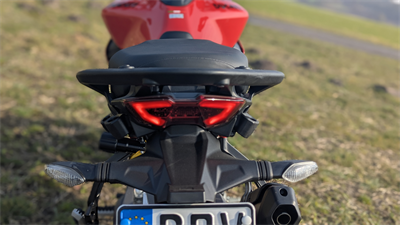
Technology of the Duc
The new 5" TFT color display of the V2 is not only very easy to read, it also shows a lot of information - and very clearly presented. You can set it to white or black. The menu navigation is logical and underlaid with very nice pictograms. There are a lot of setting options, but Ducati has managed to present them in such an easy-to-understand way that even complete tech idiots should be able to cope with them.
The technical equipment is impressive: there is cornering ABS, lean angle-dependent traction control, five configurable riding modes, cruise control, USB port, display themes, QuickShifter, Wheelie and Engine Brake Control as standard. Annoyingly, heated grips are not part of the standard equipment, and a center stand is also missing. However, these can be booked just as much as suitcases and lots of other accessories.
In terms of lighting, the new V2 does not show any weaknesses either. There are daytime running lights, automatically self-resetting LED turn signals and an emergency stop braking system. In terms of lighting design, Ducati has taken a little inspiration from the Panigale. From the rear, the V2 looks really sharp, but we also like the turn signals integrated into the fairing very much at the front. There is even a coming-home function - the lights at the front and rear remain switched on for a while after switching off the ignition (with a key, by the way) so that you can find your way home.
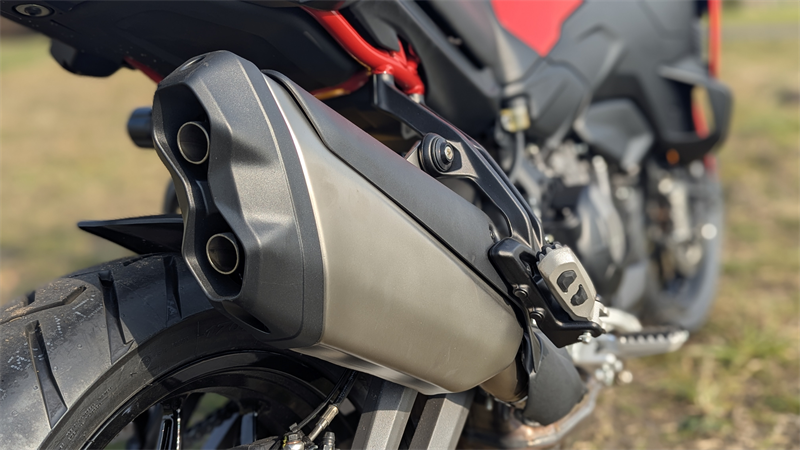 Slim rear silencer with very clearly perceptible V2 boomer sound.
Slim rear silencer with very clearly perceptible V2 boomer sound.That's how it drives - and that's how it sounds
What we noticed at the press event for the presentation of the new V2 in Valencia is also confirmed in this test. The V2 sounds extremely good, especially "from the outside". On the bike itself, in addition to the typical V2 banger, there is a clearly audible snorkeling of the airbox. This all sounds very official - you can listen to the soundcheck at the top right.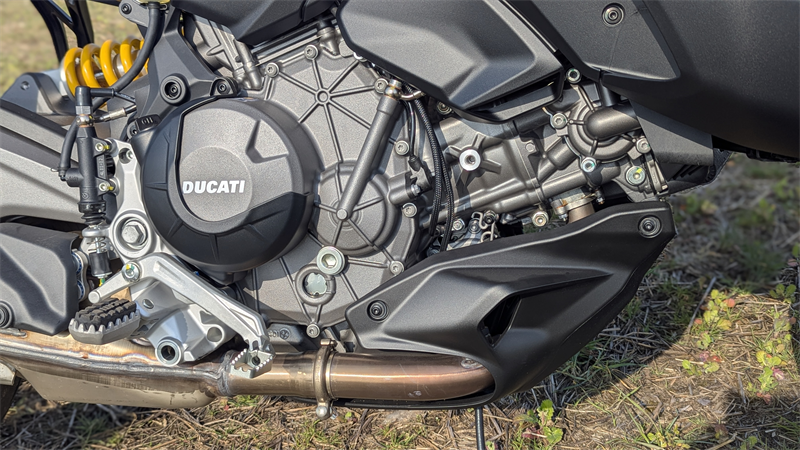
The new engine revs up willingly and runs much more refined than the older Desmo V2s. However, not everyone will like this, because as annoying as many found the rattling of the older Ducs, other riders found it just as beautiful. Whatever the case, the new V2 goes off like Schmidt's cat and doesn't punish its driver with wild chain slapping if he doesn't shift down fast enough.
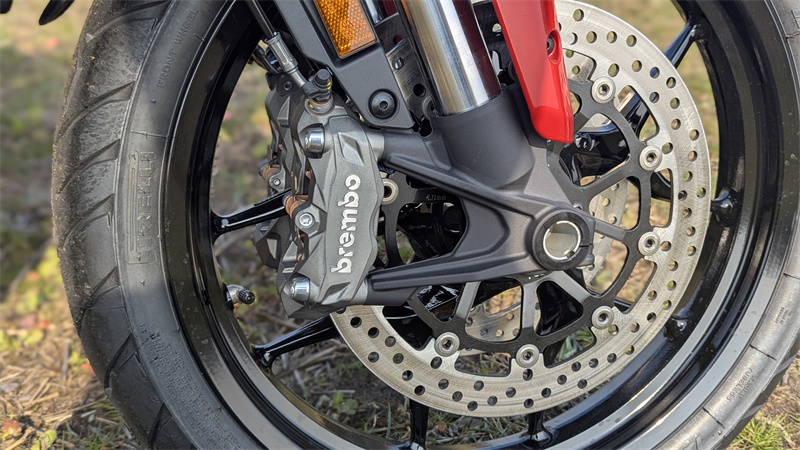
The brakes of the new Multistrada V2 are even cooler. At the front, Brembo 4-piston fixed calipers work on two 320 discs. They are supported by a Brembo radial brake pump, which reduces the required manual force when decelerating to a minimum. Stylemas are a bit more snappy, but the M4 Brembos on our test machine also work wonderfully. At the rear, the machine apparently doesn't have that much weight, so the brake at the rear regulates very quickly into the ABS area.
Warranty, Service and Competitors
It gets even more pleasing when you take a look at the warranty and service: There is a four-year warranty with no mileage limit. The service is only due every 15,000 kilometers or every two years - very good! The competitors are not so easy to spot, because the Duc Multistrada V2 is a mixture of adventure and cross-over bike. We would take the following machines into the comparison: Kawasaki Versys, Honda Africa Twin, Husqvarna Norden 901, KTM Adventure 890, Suzuki V-Strom 1050 and Triumph Tiger 900.
Result
Thanks to the weight savings, the new Multistrada V2 is significantly improved compared to its predecessor in terms of drivability and also in terms of technical equipment. The price is justified in view of the abundant technical helpers and the installed components - even compared to the competition. Ducati calls the new Multi V2 a cross-over - and that's what it is, but it's also very suitable for the really long journey, so it's also a real adventure bike somewhere.The test bike was kindly provided to us by Bergmann & Söhne in Bremervörde . By the way, both a V2S and a V2 are available there as a demonstrator for test drives. So you can compare the difference in suspension directly - if you find one, please write to us.
Price/availability/colours/years of manufacture
- Price: 15.990€
- Used (3 years old): 0.000€
- Availability: Facelift since 02/2025
- Colours: red












Further tests
Ducati Desert X in the test
Review
Ducati SuperSport 950 S tested
Review
Ducati Multistrada 1260 S
Review
Ducati Monster 1200 S
Review
Ducati Multistrada V2 S review
Review